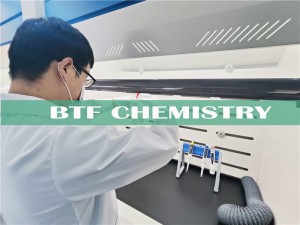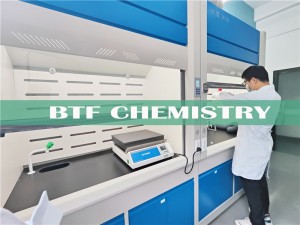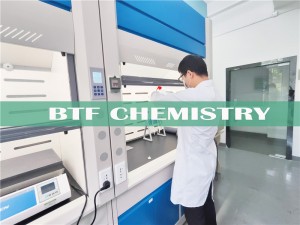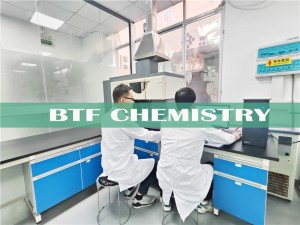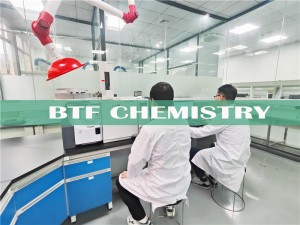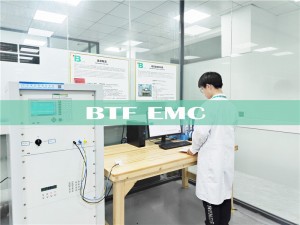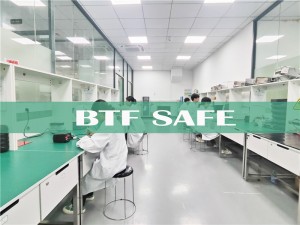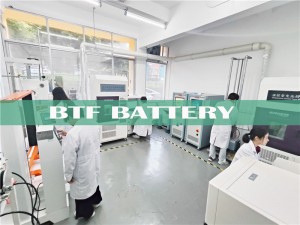BTF Testing Chemistry lab introduction
Restriction of the Using of Ten Hazardous Substances
| substance name | Limit | Test Methods | testinstrument |
|
Lead (Pb) |
1000ppm |
IEC 62321 |
ICP-OES |
|
Mercury (Hg) |
1000ppm |
IEC 62321 |
ICP-OES |
|
Cadmium (Cd) |
100ppm |
IEC 62321 |
ICP-OES |
|
Hexavalent chromium (Cr(VI)) |
1000ppm |
IEC 62321 |
UV-VIS |
|
Polybrominated Biphenyls (PBB) |
1000ppm | IEC 62321 | GC-MS |
|
(PBDE)Polybrominated diphenyl ethers (PBDEs) |
1000ppm | IEC 62321 | GC-MS |
| Di(2-ethylhexyl) phthalate (DEHP) | 1000ppm | IEC 62321&EN 14372 | GC-MS |
| Dibutyl phthalate (DBP) | 1000ppm | IEC 62321&EN 14372 | GC-MS |
| Butyl Benzyl Phthalate (BBP) | 1000ppm | IEC 62321&EN 14372 | GC-MS |
| Diisobutyl phthalate (DIBP) | 1000ppm | IEC 62321&EN 14372 | GC-MS |
Phthalate Testing
The European Commission issued Directive 2005/84/EC on December 14, 2005, which is the 22nd amendment to 76/769/EEC, the purpose of which is to limit the use of phthalates in toys and children's products. The use of this directive took effect on January 16, 2007 and was repealed on May 31, 2009. The corresponding control requirements are included in the REACH Regulations Restrictions (Annex XVII). Due to the wide use of phthalates, many well-known electronics companies have begun to control phthalates in electrical and electronic products.
Requirements (formerly 2005/84/EC) Limit
| substance name | Limit | Test Methods | Testinstrument |
| Di(2-ethylhexyl) phthalate (DEHP) | In plastic materials in toys and children's products, the content of these three phthalates shall not exceed 1000ppm |
EN 14372:2004 |
GC-MS |
| Dibutyl phthalate (DBP) | |||
| Butyl Benzyl Phthalate (BBP) | |||
| Diisononyl Phthalate (DINP) | These three phthalates must not exceed 1000ppm in plastic materials that may be placed in the mouth in toys and children's products | ||
| Diisodecyl phthalate (DIDP) | |||
| Di-n-octyl phthalate (DNOP) |
Halogen Testing
With the increasing awareness of global environmental protection, halogen-containing compounds such as halogen-containing flame retardants, halogen-containing pesticides and ozone layer destroyers will be gradually banned, forming a global trend of halogen-free. The halogen-free circuit board standard IEC61249-2-21:2003 issued by the International Electrotechnical Commission (IEC) in 2003 even upgraded the halogen-free standard from "free of some halogen compounds" to "free of halogen". Subsequently, major international well-known IT companies (such as Apple, DELL, HP, etc.) quickly followed up to formulate their own halogen-free standards and implementation schedules. At present, "halogen-free electrical and electronic products" has formed a broad consensus and become the general trend, but no country has issued halogen-free regulations, and halogen-free standards can be implemented in accordance with IEC61249-2-21 or the requirements of their respective customers.
★ IEC61249-2-21: 2003 Standard for halogen-free circuit boards
Cl≤900ppm, Br≤900ppm, Cl+Br≤1500ppm
Standard for halogen-free circuit board IEC61249-2-21: 2003
Cl≤900ppm, Br≤900ppm, Cl+Br≤1500ppm
★ High-risk materials with halogen (halogen use):
Application of Halogen:
Plastic, Flame retardants, Pesticides, Refrigerant, Clean reagent, Solvent, Pigment, Rosin flux, Electronic component, etc.
★ Halogen test method:
EN14582/IEC61189-2 Pretreatment: EN14582/IEC61189-2
Test instrument: IC (Ion Chromatography)
Organostannic Compound Testing
The European Union issued 89/677/EEC on July 12, 1989, which is the 8th amendment to 76/769/EEC, and the directive stipulates that it cannot be sold on the market as a biocide in freely cross-linked antifouling coatings and its formulation ingredients. On May 28, 2009, the European Union adopted Resolution 2009/425/EC, further restricting the use of organotin compounds. Since June 1, 2009, the restriction requirements of organotin compounds have been included in the control of REACH regulations.
Reach Restriction (original 2009/425/EC) are as follows
| substance | time | Require | restricted use |
|
Tri-substituted organotin compounds such as TBT, TPT |
From July 1, 2010 |
Tri-substituted organotin compounds with a tin content exceeding 0.1% shall not be used in articles |
Items not to be used in |
|
Dibutyltin compound DBT |
From January 1, 2012 |
Dibutyltin compounds with a tin content exceeding 0.1% shall not be used in articles or mixtures |
Not to be used in articles and mixtures, individual applications extended until January 1, 2015 |
|
DOTDioctyltin compound DOT |
From January 1, 2012 |
Dioctyltin compounds with a tin content exceeding 0.1% shall not be used in certain articles |
Items covered: textiles, gloves, child care products, diapers, etc. |
PAHs Testing
In May 2019, the German Product Safety Committee (Der Ausschuss für Produktsicherheit, AfPS) released a new standard for the testing and evaluation of polycyclic aromatic hydrocarbons (PAHs) in GS certification: AfPs GS 2019:01 PAK (the old standard is: AfPS GS 2014: 01 PAK). The new standard will be implemented from July 1, 2020, and the old standard will become invalid at the same time.
PAHs requirements for GS mark certification (mg/kg)
| project |
one type |
Class II |
three categories |
|
Items that can be put in the mouth or materials that come into contact with skin for children under 3 years of age |
Items not regulated in a class, and items that are in frequent contact with the skin and the contact time exceeds 30 seconds (long-term contact with the skin) |
Materials not included in categories 1 and 2 and expected to be in contact with skin for no more than 30 seconds (short-term contact) |
|
| (NAP) Naphthalene (NAP) |
<1 |
< 2 |
< 10 |
| (PHE)Philippines (PHE) |
Total <1 |
Total <10 |
Total <50 |
| (ANT) Anthracene (ANT) | |||
| (FLT) Fluoranthene (FLT) | |||
| Pyrene (PYR) | |||
| Benzo(a)anthracene (BaA) |
<0.2 |
<0.5 |
<1 |
| Que (CHR) |
<0.2 |
<0.5 |
<1 |
| Benzo(b)fluoranthene (BbF) |
<0.2 |
<0.5 |
<1 |
| Benzo(k)fluoranthene (BkF) |
<0.2 |
<0.5 |
<1 |
| Benzo(a)pyrene (BaP) |
<0.2 |
<0.5 |
<1 |
| Indeno(1,2,3-cd)pyrene (IPY) |
<0.2 |
<0.5 |
<1 |
| Dibenzo(a,h)anthracene (DBA) |
<0.2 |
<0.5 |
<1 |
| Benzo(g,h,i)Perylene (BPE) |
<0.2 |
<0.5 |
<1 |
| Benzo[j]fluoranthene |
<0.2 |
<0.5 |
<1 |
| Benzo[e]pyrene |
<0.2 |
<0.5 |
<1 |
| Total PAHs |
<1 |
< 10 |
< 50 |
Authorization and Restriction of Chemicals REACH
REACH is the abbreviation of EU Regulation 1907/2006/EC (Registration, Evaluation, Authorisation, and Restriction of Chemicals). The Chinese name is "Registration, Evaluation, Authorization and Restriction of Chemicals", which was officially launched on June 1, 2007. effective.
Substances of Very High Concern SVHC:
Substances of very high concern. It is a general term for a large class of hazardous substances under the REACH regulation. SVHC includes a series of highly hazardous substances such as carcinogenic, teratogenic, reproductive toxicity, and bioaccumulation.
Restriction
REACH Article 67(1) requires that substances listed in REACH Annex XVII (by themselves, in mixtures or in articles) shall not be manufactured, placed on the market and used unless restricted conditions are complied with。
Requirements of Restriction
On June 1, 2009, the REACH Restriction List (Annex XVII) came into effect, replacing 76/769/EEC and its multiple amendments. Up to now, the REACH restricted list includes 64 items totaling more than 1,000 substances.
In 2015, the European Union successively published Commission Regulations (EU) No 326/2015, (EU) No 628/2015 and (EU) No1494/2015 in its official gazette, targeting REACH Regulation (1907/2006/EC) Annex XVII ( Restriction List) was revised to update PAHs detection methods, restrictions on lead and its compounds, and limit requirements for benzene in natural gas.
Appendix XVII lists the conditions for restricted use and the restricted content for various restricted substances.
Key points of operation
Accurately understand the restricted areas and conditions for various substances;
Screen out the parts that are closely related to your own industry and products from the huge list of restricted substances;
Based on rich professional experience, screen out high-risk areas that may contain restricted substances;
Restricted substance information investigation in supply chain requires effective delivery tools to ensure accurate information and cost savings.
Other Test Items
| substance name | Guideline | Material at risk | test instrument |
| Tetrabromobisphenol A | EPA3540C |
PCB board, plastic, ABS board, rubber, resin, textile, fiber and paper, etc. |
GC-MS |
|
PVC |
JY/T001-1996 |
Various PVC sheets and polymer materials |
FT-IR |
|
asbestos |
JY/T001-1996 |
Building materials, and paint fillers, thermal insulation fillers, wire insulation, filter fillers, fireproof clothing, asbestos gloves, etc. |
FT-IR |
|
carbon |
ASTM E 1019 |
all materials |
Carbon and sulfur analyzer |
|
sulfur |
Ashing |
all materials |
Carbon and sulfur analyzer |
|
Azo compounds |
EN14362-2 & LMBG B 82.02-4 |
Textiles, plastics, inks, paints, coatings, inks, varnishes, adhesives, etc. |
GC-MS/HPLC |
|
total volatile organic compounds |
Thermal analysis method |
all materials |
Headspace-GC-MS |
|
phosphorus |
EPA3052 |
all materials |
ICP-AES or UV-Vis |
|
Nonylphenol |
EPA3540C |
non-metallic material |
GC-MS |
|
short chain chlorinated paraffin |
EPA3540C |
Glass, cable materials, plastic plasticizers, lubricating oils, paint additives, industrial flame retardants, anticoagulants, etc. |
GC-MS |
|
substances that destroy the ozone layer |
Tedlar collection |
Refrigerant, heat insulating material, etc. |
Headspace-GC-MS |
|
Pentachlorophenol |
DIN53313 |
Wood, Leather, Textiles, Tanned Leather, Paper, etc.
|
GC-ECD |
|
formaldehyde |
ISO17375/ISO14181-1&2/EN120GB/T 18580 |
Textiles, resins, fibers, pigments, dyes, wood products, paper products, etc. |
UV-VIS |
|
Polychlorinated naphthalenes |
EPA3540C |
Wire, wood, machine oil, electroplating finishing compounds, capacitor manufacturing, testing oil, raw materials for dye products, etc. |
GC-MS |
|
Polychlorinated terphenyls |
EPA3540C |
As a coolant in transformers and as insulating oil in capacitors, etc. |
GC-MS, GC-ECD |
|
PCBs |
EPA3540C |
As a coolant in transformers and as insulating oil in capacitors, etc. |
GC-MS, GC-ECD |
|
Organotin compounds |
ISO17353 |
Ship hull antifouling agent, textile deodorant, antimicrobial finishing agent, wood product preservative, polymer material, such as PVC synthetic stabilizer intermediate, etc. |
GC-MS |
|
Other trace metals |
In-housed method & US |
all materials |
ICP,AAS, UV-VIS |
Information for restriction of hazardous substances
| Relevant laws and regulations | Hazardous Substance Control |
| Packaging Directive 94/62/EC & 2004/12/EC | Lead Pb + Cadmium Cd + Mercury Hg + Hexavalent Chromium <100ppm |
| US Packaging Directive - TPCH | Lead Pb + Cadmium Cd + Mercury Hg + Hexavalent Chromium <100ppmPhthalates <100ppm
PFAS prohibited (must not be detected) |
| Battery Directive 91/157/EEC & 98/101/EEC & 2006/66/EC | Mercury Hg <5ppm Cadmium Cd <20ppm Lead Pb <40ppm |
| Cadmium Directive REACH Annex XVII | Cadmium Cd<100ppm |
| Scrap Vehicles Directive 2000/53/EEC | Cadmium Cd<100ppm Lead Pb <1000ppmMercury Hg<1000ppm Hexavalent chromium Cr6+<1000ppm |
| Phthalates Directive REACH Annex XVII | DEHP+DBP+BBP+DIBP ≤0.1wt%;DINP+DIDP+DNOP≤0.1wt% |
| PAHs Directive REACH Annex XVII | Tire and filler oil BaP < 1 mg/kg ( BaP, BeP, BaA, CHR, BbFA, BjFA, BkFA, DBAhA ) total content < 10 mg/kg direct and long-term or short-term repeated contact with human skin or plastics Or any PAH <1mg/kg for rubber parts, any PAHs <0.5mg/kg for toys |
| Nickel Directive REACH Annex XVII | Nickel release <0.5ug/cm/week |
| Dutch Cadmium Ordinance | Cadmium in pigments and dye stabilizers < 100ppm, cadmium in gypsum < 2ppm, cadmium in electroplating is prohibited, and cadmium in photographic negatives and fluorescent lamps is prohibited |
| Azo Dyestuffs Directive REACH Annex XVII | < 30ppm for 22 carcinogenic azo dyes |
| REACH Annex XVII | Restricts cadmium, mercury, arsenic, nickel, pentachlorophenol, polychlorinated terphenyls, asbestos and many other substances |
| California Bill 65 | Lead <300ppm (for wire products attached to general electronic appliances |
| California RoHS | Cadmium Cd<100ppm Lead Pb<1000ppmMercury Hg<1000ppm Hexavalent chromium Cr6+<1000ppm |
| Code of Federal Regulations 16CFR1303 Restrictions on Lead-Containing Paint and Manufactured Products | Lead Pb<90ppm |
| JIS C 0950 Hazardous Substance Labeling System for Electrical and Electronic Products in Japan | Restricted use of six hazardous substances |




